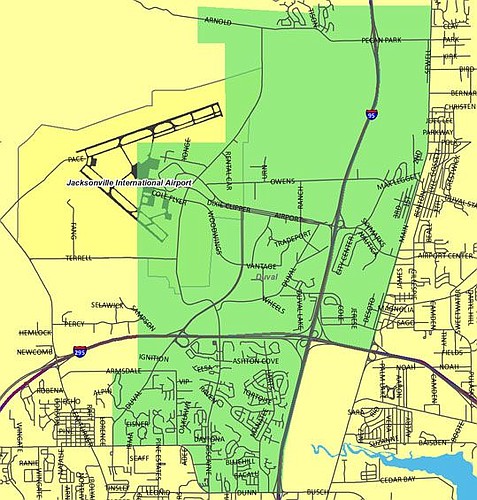
There are three possible futures for the Jacksonville International Airport Community Redevelopment Area:
• Leave it the way it is and let it expire in 2023 – the original plan for the special district in North Jacksonville in which the increase in ad valorem taxes from increased property values are set aside for economic development projects within the district.
• Amend it and focus on areas of the district that haven’t been improved by the program.
• Abolish it four years early in 2019 – the recommendation of the JIA CRA Advisory Board.
The 19 members of City Council serve as the CRA’s board of directors. They met Wednesday to evaluate the performance of the program since it was established in 1993 and use the evaluation to determine its future.
The board was presented a positive – almost glowing – report, but had questions about its conclusions.
A $95,000 study and assessment of the CRA commissioned by the city Office of Economic Development was presented by Brian Wheeler, executive vice president of Genesis Group.
He said when the CRA was established, 41 percent of the housing in the district was substandard, but based on data from the 2010 U.S. Census, the percentage has declined to 2.2 percent – 0.7 percent below the substandard housing percentage in Duval County as a whole.
Council Vice President John Crescimbeni said despite new residential development, much of the substandard housing that was inventoried in 1993 remains in the district.
Wheeler said the CRA plan was based on new construction on undeveloped land, not improving existing housing stock.
“Adding new housing dilutes the substandard housing. We want to eliminate it,” Crescimbeni said.
Council member Anna Lopez Brosche pointed out that despite the major projects in the district, such as the River City Marketplace shopping and entertainment complex, blighted housing and infrastructure needs still exist in the southern portion of the CRA.
Wheeler said parts of the district that remain blighted helped establish the CRA conditions and improving housing wasn’t the focus of the plan.
“The economic development strategy focused on large projects that would generate additional tax revenue,” Wheeler said. “In some areas, there’s work to be done.”
Council member Aaron Bowman agreed River City Marketplace is “doing great” but most of the district south of Interstate 295 continues to lack basic needs such as sewer service, sidewalks and streetlights.
“I think we’ve left a lot of stuff on the table that we could have done,” he said.
District 7 Council member Reggie Gaffney, who represents part of the CRA, said he isn’t aware of any projects funded near Dunn Avenue, which he said is the area most in need of redevelopment.
In the portion of the CRA that’s in his council district, “we don’t have a project” and concentrating improvement efforts on only part of the CRA “is like getting half a haircut,” he said.
The study also said that in 1993, 54 percent of the land in the CRA was vacant or underutilized. By 2015 the percentage had decreased to 15.1 percent, compared to 19.1 percent for the entire county.
In terms of roadways, the linear feet of right-of-way per acre of land increased from 103.3 in 1993 to 207 feet in 2015, comparable to other suburban areas of the county.
Wheeler said based on the study, the CRA has “accomplished elimination of blight conditions” and “it’s been a very successful CRA.”
Stephen Swann, chair of the JIA CRA Advisory agreed. “It’s probably the most successful CRA in the state,” he said.
On the financial side, Kirk Wendland, director of the city Office of Economic Development, said projected revenue of the CRA in the current budget year is $9.1 million, anticipated to increase to at least $9.4 million in the 2017-18 budget and then by “another couple of million” in 2018-19 when the Amazon.com facility under construction opens.
Revenue is used for incentives granted by the city to businesses and developers that increase the tax base within the district.
Under state law, funds from the CRA may be used only within the district and only to eliminate slums and blight by adopting and implementing redevelopment plans.
The current balance in the fund is $1.8 million, Wendland said.
Putting any new CRA projects in the pipeline might be a moot point, said Karen Nasrallah, city economic manager.
Bills are moving through the Florida House and Senate that if enacted would abolish all CRAs in the state, effective Oct. 1, she said.
Ali Korman Shelton, director of intergovernmental affairs for Mayor Lenny Curry, said although the House bill looks likely to pass, the Senate version is yet to be heard in four committees and the deadline for being out of committee and ready for a vote is April 25, less than a month away.
If legislation to abolish CRAs is enacted, Shelton said, no new projects would be allowed unless they were to be funded out the current budget year.
When she opened the meeting, council President Lori Boyer said the intent Wednesday was not to vote on any proposals or options and the local decision on the fate of the JIA CRA and its development subsidies will continue to be considered.
In the meantime, “we need to give people the heads-up those may not be available in the future,” she said.
(904) 356-2466